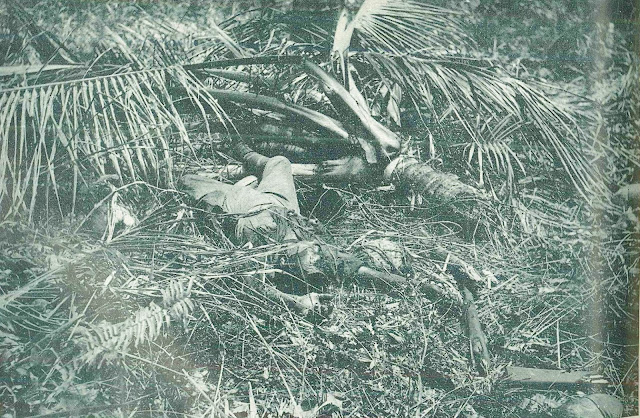An Austrian soldier shot a Japanese sniper who was hiding in a coconut tree in the jungle on the island of Papua New Guinea. The shot Japanese sniper fell from the high coconut tree and was killed in action. The coconut tree, sniper rifle, and water bottle were scattered beside the body of the Japanese soldier who was lying on his back. Most of the deaths of Japanese soldiers were not from direct combat, but from malnutrition and starvation due to tropical infections and starvation. Because of the tropical climatic conditions, the area is not suitable for the production of food such as field crops of grain.
During World War II, Japanese troops invaded the village of Buna on the northern coast of the island of Papua New Guinea starting on July 21, 1942, and established a base at Buna Airfield. Australian and U.S. troops recaptured the airfield in the Battle of Buna Gona, where Japanese forces were annihilated on January 2, 1943. The island of New Guinea is the second largest, most rugged and equatorial island in the world, about twice the size of Japan. Australian troops landed in Miru Bay in mid-December 1942 to support the Americans, who invaded Buna Airfield from December 18 and occupied it on December 23.
The Battle of Buna was an Allied attack on the Japanese coast redoubt on the north coast of Papua from November 19, 1942 to January 2, 1943. The coast barrier was constructed so that the Japanese could make a land attack on Port Moresby over the Kokoda Road. Australian counterattacks broke out within about 48 km of Port Moresby to push the Japanese back along the Kokoda.
In July and August 1942, the Japanese landed some 11,000 battle-hardened Japanese soldiers near Buna on the north coast of New Guinea. The Japanese soldiers twisted their way through the jungle to an airfield in Port Moresby, the capital of Australia, about 160 kilometers southwest of Buna. The Australians barely beat back the Japanese, forcing the Japanese to retreat to open a gap between Buna and nearby villages. American troops landed at Port Moresby to assist the Australians in defeating the Japanese. Thereafter, American and Australian soldiers fought the Japanese for about two months with heavy fighting and heavy casualties. The Japanese soldiers did not stop resisting until they were dead, which cost the Allied forces a lot of damage. About 2,300 Allied troops were killed and about 12,000 wounded in action. For the Japanese, more than 6,000 were killed, about 1,200 were wounded, and only about 200 POWs survived.

